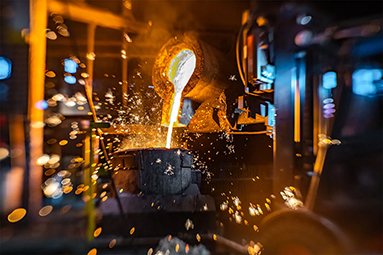New Computational Model Enables Alloy Design for Real Materials

MIE Professor Moneesh Upmanyu’s new research paper, “Solute-drag Forces From Short-time Equilibrium Fluctuations of Crystalline Interfaces,” was selected as an Editor’s Pick by the Journal of Applied Physics. He discovered a faster, cost-efficient, and more accurate computational model for alloy design of real materials.
This article originally appeared on Northeastern Global News. It was published by Alena Kuzub. Main photo: By engineering material defects and behaviors of solutes in alloys, humans can make stronger, cost-effective materials, says Moneesh Upmanyu, professor of mechanical and industrial engineering at Northeastern University. Photo by Matthew Modoono/Northeastern University
New computational model by Northeastern scientists revolutionizing alloy design
Humans began creating alloys around 5,000 years ago by combining copper and tin to produce bronze. Since then, alloy design has advanced dramatically, says Moneesh Upmanyu, professor of mechanical and industrial engineering at Northeastern University.
“Now, it’s definitely a science [and] less of an art because we have the periodic table and we know the properties of all these elements that we are mixing together,” he says.
The Journal of Applied Physics recently selected Upmanyu’s new research paper on alloy design as an Editor’s Pick.

Humans began creating alloys around 5,000 years ago by combining copper and tin to produce bronze. Getty Images
The paper introduces a new computational model that offers strategies for alloy design of real materials in seconds. Compared to traditional lab experiments and AI-based approaches, the model offers greater speed, cost efficiency and accuracy.
The work was conducted in collaboration with Changjian Wang, a former Northeastern graduate student.
Previous computational tools—including those based on machine learning and artificial intelligence—often failed to account for a critical factor, Upmanyu says: real-life crystalline materials, such as metals and ceramics, contain defects.
In materials science, defects are irregularities or imperfections in a crystal’s atomic structure. While they may sound like flaws, defects are often intentionally introduced to enhance properties such as strength, conductivity and corrosion resistance.
The new model takes into account an important class of material defects (grain boundaries) and the tendency of the mixed solutes to gather—or segregate—around the structural imperfections during alloy formation.
“You are dealing with these defective materials by default, and all these alloy design techniques ignore this,” Upmanyu says. “They just can’t factor that in because it’s a very complex system with all these defects in place.”
Read full story at Northeastern Global News